Switching to non-toxic and eco-friendly alternatives for fluid art can seem like a lot, but trust me, your lungs and the planet will thank you. Think water-mixable oil paints that save you from those nasty solvents and clean up with just soap and water. Ever heard of methylcellulose for gesso? It's like magic, providing a smooth canvas without the toxic fumes. And let's not forget natural earth pigments, which offer vibrant colors guilt-free. By choosing eco-friendly materials like walnut oil and citrus-based cleaners, you can create stunning artwork while being kind to yourself and the environment. Curious about making your art more eco-friendly?
Key Takeaways
- Water-mixable oil paints offer vibrant colors and easy soap-and-water cleanup, eliminating harsh solvents.
- Natural earth pigments provide non-toxic, vibrant colors without harmful chemicals, sourced sustainably.
- Eco-friendly solvents like citrus-based cleaners and Gamsol Solvent Free Gel minimize harmful chemical exposure.
- Methylcellulose serves as a non-toxic gesso alternative, ensuring excellent adhesion and surface preparation.
Health and Safety Concerns
Health and safety concerns are paramount when considering the use of traditional oil paints in fluid art due to the presence of harmful solvents and toxic heavy metals. These traditional paints might look vibrant and beautiful, but the dangers they pose are no joke. Imagine spending hours surrounded by paints that contain lead or mercury. Scary, right? Long-term exposure to these toxic materials can lead to serious health issues, including cancer. This risk is even more worrisome for pregnant artists and children who might be around these supplies.
Artist health is a big deal, and understanding the risks of toxic exposure is vital. Not only do these harmful substances affect the artist directly, but they also create an unsafe environment for anyone nearby. Think about your kids or pets who might share your creative space. No one wants to put their loved ones at risk.
It's essential to be aware of what's in your art supplies. Knowing that certain colors in traditional oil paints contain dangerous heavy metals makes it clear why finding safer alternatives is so important. Choosing non-toxic materials isn't just a trend; it's a necessary step for keeping everyone healthy and safe.
Transition to Non-Toxic Art
Shifting to non-toxic art materials is an essential step for artists aiming to safeguard their health and the environment while maintaining the quality of their work. Traditional paints often contain harmful solvents and heavy metals, posing significant health risks over time. Fortunately, art material innovations are paving the way for safer creative practices.
Water-mixable oil paints and non-toxic mediums like walnut oil offer vibrant, fluid art without the dangers associated with turpentine or traditional oil mediums. Artists are increasingly aware of the risks and are seeking out alternatives that prioritize health and sustainability.
- Water-mixable oil paints: These eliminate the need for harsh solvents, making clean-up easier and safer.
- Walnut oil: A non-toxic medium that provides a smooth, glossy finish without harmful fumes.
- Methylcellulose for gesso: This eco-friendly option prepares canvases without the environmental cost of synthetic alternatives.
Switching to non-toxic paints like milk paint or casein guarantees the safety of artists, children, and pets. By adopting these eco-friendly alternatives, artists not only enhance their health but also contribute to a greener planet.
Eco-Friendly Solvents
Eco-friendly solvents are revolutionizing the way artists approach solvent use, providing safer alternatives without compromising on performance. These innovative solutions, such as Sennelier Green Thinner, offer a safer way to thin paints, though they may evaporate more slowly and still carry some inhalation risks. Nonetheless, they represent a significant step towards sustainable sourcing and reducing toxic exposure in art studios.
One standout solvent alternative is walnut oil. This non-toxic option not only thins oil paints but also cleans brushes effectively, all while maintaining the vibrancy of colors. Artists can breathe easier knowing they aren't inhaling harmful fumes.
Another excellent choice is Gamsol Solvent Free Gel, which minimizes harmful chemical exposure while still performing effectively in thinning paints.
For those who prefer natural solutions, citrus-based cleaners are a fantastic replacement for traditional solvents. These natural solvents are not only non-toxic but also highly effective in cleaning brushes and tools, making them a favorite among eco-conscious artists.
Water-Mixable Oil Paints
Water-mixable oil paints offer a fantastic, safe option for artists looking to avoid harmful solvents.
These paints maintain vibrant color retention, allowing for rich, expressive artwork without compromising on quality.
Additionally, the easy cleanup process with just water makes them a convenient and eco-friendly choice for both professionals and hobbyists alike.
Safe Solvent-Free Options
Utilizing water-mixable oil paints, artists can achieve the rich texture and vibrant pigmentation of traditional oil paints without the need for hazardous solvents.
These innovative paints bring numerous benefits, making them a preferred choice for both new and seasoned artists. They can be thinned and cleaned with simple water, eliminating the need for toxic chemicals and ensuring a safer studio environment.
Artist testimonials often highlight the seamless shift to water-mixable oils, noting the ease of use and environmental advantages. Brands like Winsor & Newton and Gamblin have developed water-mixable options that deliver excellent blending capabilities and a professional finish.
Here are some key advantages of water-mixable oil paints:
- Healthier Studio Environment: Reduced exposure to harmful solvents means better air quality and fewer health risks.
- Eco-Friendly: Lower volatile organic compounds (VOCs) make these paints more environmentally responsible.
- Ease of Cleanup: Simple soap and water suffice for cleaning, simplifying the process.
Vibrant Color Retention
One of the most notable attributes of water-mixable oil paints is their ability to retain vibrant color intensity, comparable to traditional oil paints, while offering a safer and more environmentally friendly alternative. These paints shine in color vibrancy techniques, thanks to their unique formulation that uses non-toxic emulsifiers. This means you get the same brilliant hues without worrying about harmful chemicals.
Pigment stability factors are key here. The pigments in water-mixable oil paints are stable and long-lasting, ensuring that your artwork remains as vivid as the day you created it. This is particularly important in fluid art, where the blending and manipulation of colors are essential. With water-mixable oils, you have more time to perfect your work since they dry slower than acrylics.
In addition to their eco-friendly nature, these paints don't require toxic solvents for thinning or cleaning, which is a big win for both your health and the environment. Many brands even use eco-friendly practices in their production, further reducing their environmental impact. So, you can create stunning, vibrant art while also being kind to the planet.
Easy Cleanup Process
The convenience of cleaning water-mixable oil paints with simple soap and water offers a significant advantage over traditional oil paints. Gone are the days of dealing with smelly, harsh solvents that take forever to clean up. With water-mixable oil paints, you just rinse your brushes and tools in water, making the cleanup process super easy and safe.
Imagine this:
- No more harsh chemicals: You won't need to worry about those nasty solvents that can harm you and the environment.
- Quick and easy: Just a little soap and water, and your brushes are as good as new.
- Eco-friendly: Using water instead of solvents means fewer volatile organic compounds (VOCs) in the air, which is better for everyone.
This simpler water cleanup method not only makes painting more enjoyable but also safer for your health and the planet. With water-mixable oil paints, you can plunge into your art without the stress of a complicated cleanup, knowing you're making a safer choice for both you and the environment.
Methylcellulose for Gesso
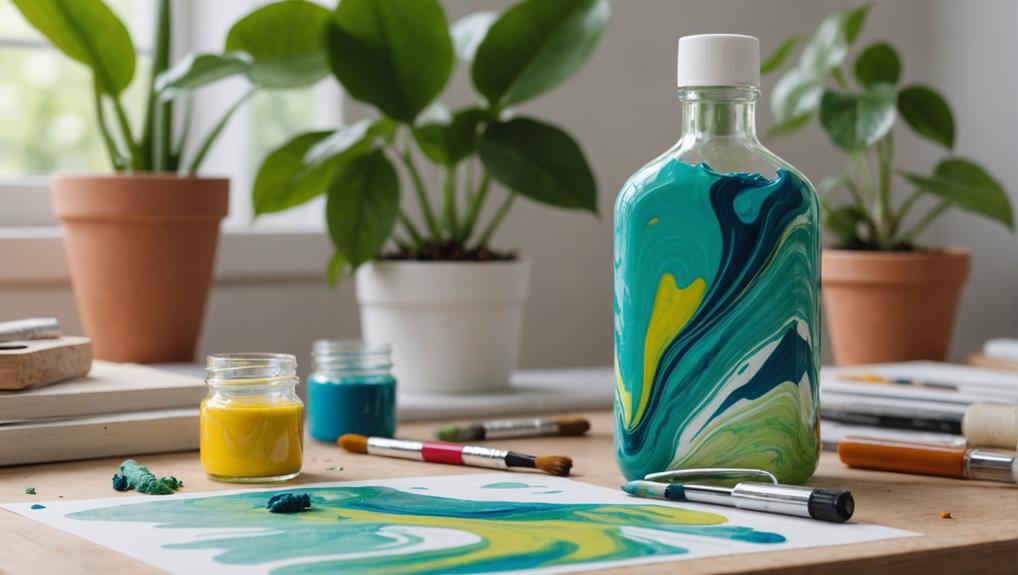
Methylcellulose gesso offers numerous benefits for artists looking for a safer, eco-friendly alternative to traditional gesso, making it an excellent choice for those concerned about harmful chemicals.
This plant-based adhesive not only enhances paint application but also provides a clear, neutral pH layer that preserves the quality of your artwork over time.
With its versatility in creating textured effects and its suitability for educational settings, exploring application techniques and tips can help you maximize its potential in your fluid art projects.
Benefits of Methylcellulose Gesso
Incorporating methylcellulose gesso into your art practice offers a non-toxic, eco-friendly alternative that enhances both the safety and versatility of your materials. Derived from plant cellulose, this innovative gesso guarantees that artists can create without worrying about harmful chemicals, benefiting both personal health and the environment.
One of the standout methylcellulose properties is its excellent adhesion, providing a smooth, flexible surface that greatly improves gesso application. This allows for a seamless integration of paints and other mediums, making your artwork more vibrant and durable. Additionally, methylcellulose gesso dries clear and can be reactivated with water, giving you the flexibility to adjust your work even after it has dried.
Furthermore, the biodegradable nature of this gesso means it produces minimal waste, aligning with eco-friendly practices and considerably reducing the environmental impact of your art supplies. Its versatility is also remarkable, as it can be applied to a variety of surfaces, including paper, canvas, and wood, catering to diverse artistic needs.
- Derived from plant cellulose: Guarantees non-toxic, safe use
- Excellent adhesion and flexibility: Improves surface preparation
- Dries clear and reactivates with water: Allows adjustments post-drying
Embrace the benefits of methylcellulose gesso and create with confidence and care.
Application Techniques and Tips
Building on the benefits of methylcellulose gesso, mastering its application techniques can considerably enhance both the quality and sustainability of your fluid art projects.
Start by mixing methylcellulose with water to create a smooth, flexible base. This eco-friendly gesso offers excellent paint adhesion, whether you're using acrylics or natural pigments.
When it comes to texture techniques, you can easily apply methylcellulose gesso with brushes or rollers. For a smooth finish, use a wide brush or roller to spread evenly. If you prefer a more textured surface, experiment with different brush strokes or add materials like sand to the gesso before applying. This allows for versatile and creative expression without the need for solvents.
Layering methods are also straightforward with methylcellulose gesso. Since it dries relatively quickly, you can build up multiple layers to achieve the desired opacity and texture. Each layer should be thin and even, guaranteeing a uniform base for your fluid art.
Sustainable Priming Options
Exploring sustainable priming options for fluid art can greatly reduce environmental impact while maintaining high-quality artistic results.
Hemp canvas stands out for its numerous benefits, such as being more sustainable than traditional cotton due to its minimal pesticide requirements. This makes it a healthier choice for farming and the environment.
Linen, on the other hand, is revered for its durability and breathability. The qualities of linen make it an excellent, biodegradable option, ensuring that your art practices align with sustainability goals.
For those looking to avoid synthetic fertilizers or pesticides, organic cotton canvas is a fantastic alternative. It offers a safer option for both artists and the environment.
Another innovative and eco-friendly choice is methylcellulose, a plant-based, non-toxic alternative to traditional gesso. It provides a safe and effective primer for various painting surfaces.
Additionally, reusing old canvases not only minimizes waste but also revives materials that would otherwise be discarded. By incorporating these sustainable priming options, artists can notably lower their ecological footprint without sacrificing the quality of their artwork.
- Hemp Canvas: Requires fewer pesticides, promoting healthier farming.
- Linen: Durable, breathable, and biodegradable.
- Organic Cotton Canvas: Grown without synthetic fertilizers or pesticides.
Benefits of Earth Pigments
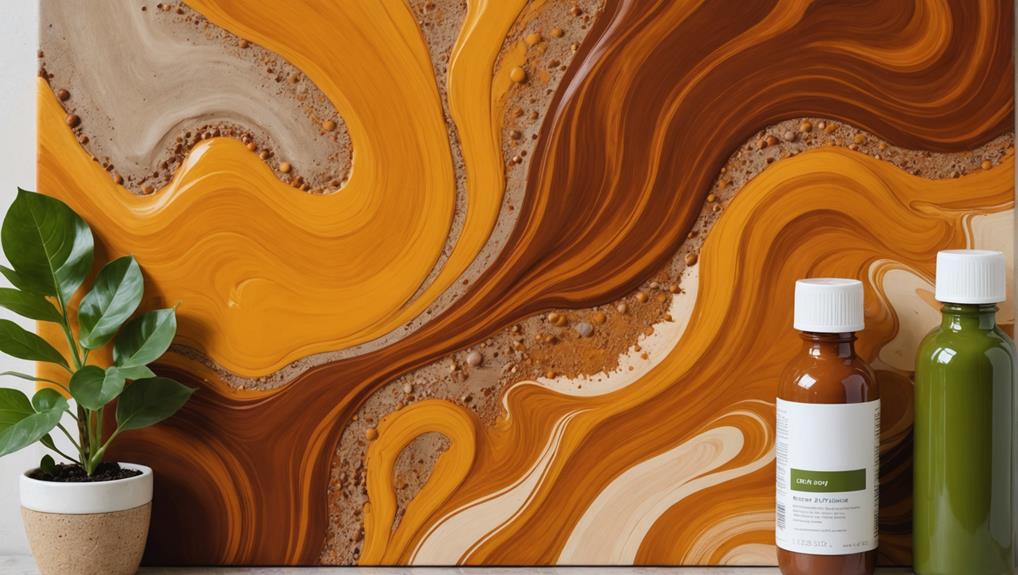
Earth pigments, sourced from natural minerals and clays, provide a non-toxic and safe alternative for artists of all ages. These pigments have a long history and are celebrated for their vibrant and durable colors that remain archival, meaning they do not fade or deteriorate over time.
Earth pigment sourcing guarantees that these materials are derived from eco-friendly processes, often involving minimal harmful processing compared to synthetic alternatives. This makes them a sustainable choice for environmentally conscious artists.
One of the standout features of earth pigments is their resilience to environmental conditions such as light and humidity. This characteristic guarantees the longevity of artworks, maintaining their brilliance and integrity over years.
In addition, natural color mixing with these pigments allows for a broad spectrum of hues, providing artists with the flexibility to create unique and expressive pieces.
Aside from their durability, earth pigments can outshine many commercial paints regarding color intensity and quality. This superior performance, coupled with their eco-friendly nature, makes them an excellent choice for fluid art projects.
Embracing earth pigments not only enhances artistic expression but also supports sustainable art practices, contributing to a healthier planet.
Homemade Natural Paints
Creating your own natural paints at home is not only fun but also a great way to guarantee you're using safe and eco-friendly materials.
Simple recipes using flour, water, and earth pigments can yield beautiful, vibrant colors, and you can use DIY binding agents like gum arabic or casein to make certain the paint sticks well and looks great.
Simple Paint Recipes
Homemade natural paints, made from simple ingredients like flour, water, and natural pigments, offer a non-toxic and eco-friendly alternative for artists and children. These paints are not only safe but also easy to create at home, providing a delightful and sustainable approach to art.
Creating your own paints is straightforward and rewarding. Here are a few simple recipes:
- Milk Paint: Mix equal parts of milk, vinegar, and lime. This results in a biodegradable paint that adheres well to surfaces and dries with a lovely matte finish.
- Egg Tempera: Combine egg yolk with water and natural pigments. This homemade medium is vibrant and perfect for fine details in your artwork.
- Clay Paint: Blend clay with water and natural colorants. This mixture produces a breathable, eco-friendly paint ideal for interior walls and artistic projects.
These homemade mediums not only guarantee a safer painting experience but also reduce environmental impact. By using natural colorants, artists can create beautiful, non-toxic art while being kind to the planet.
Safe Pigment Sources
Selecting the right pigment sources is paramount to guaranteeing that homemade natural paints remain both vibrant and safe for artists and the environment.
When diving into natural pigment sourcing, earth pigments emerge as a top choice. These archival and non-toxic pigments not only produce vibrant colors but are also safe for artists of all ages, making them a sustainable color option.
Natural pigments can be sourced from various materials. For instance, the rich ochres and siennas are derived from iron oxides in the soil, while ultramarine can be made from ground lapis lazuli. These materials are readily available and biodegradable, guaranteeing minimal environmental impact.
Additionally, plant-based colors offer sustainable color options. Turmeric can produce a bright yellow, beetroot yields a deep red, and spirulina provides a vibrant green. These plant-based pigments are not only eco-friendly but also introduce a fun, exploratory element to the paint-making process.
Combining these natural pigments with water or plant-based oils, such as walnut oil, can further enhance the vibrancy of homemade paints. This approach not only promotes a healthier alternative to conventional synthetic paints but also guarantees a creative and engaging experience for artists seeking non-toxic and eco-friendly solutions.
DIY Binding Agents
In the pursuit of crafting eco-friendly fluid art, utilizing DIY binding agents such as gum arabic, egg yolk, casein, and methyl cellulose can greatly improve the quality and sustainability of homemade natural paints. Each of these natural binders offers unique properties, making them suitable for various alternative binding methods.
- Gum arabic: This non-toxic adhesive dissolves easily in water, making it perfect for watercolor and gouache paints. Its natural binder properties help create smooth, vibrant colors.
- Egg yolk: Historically used in tempera paint, egg yolk provides a quick-drying, luminous finish. It's ideal for layering techniques, adding depth and texture to fluid art.
- Casein: Derived from milk, casein is a durable and fast-drying option. While not suitable for vegans, its natural binder properties guarantee long-lasting, eco-friendly art.
Homemade paints combining earth pigments with these natural binders eliminate toxins and provide vibrant, archival quality.
Non-Toxic Paint Varieties
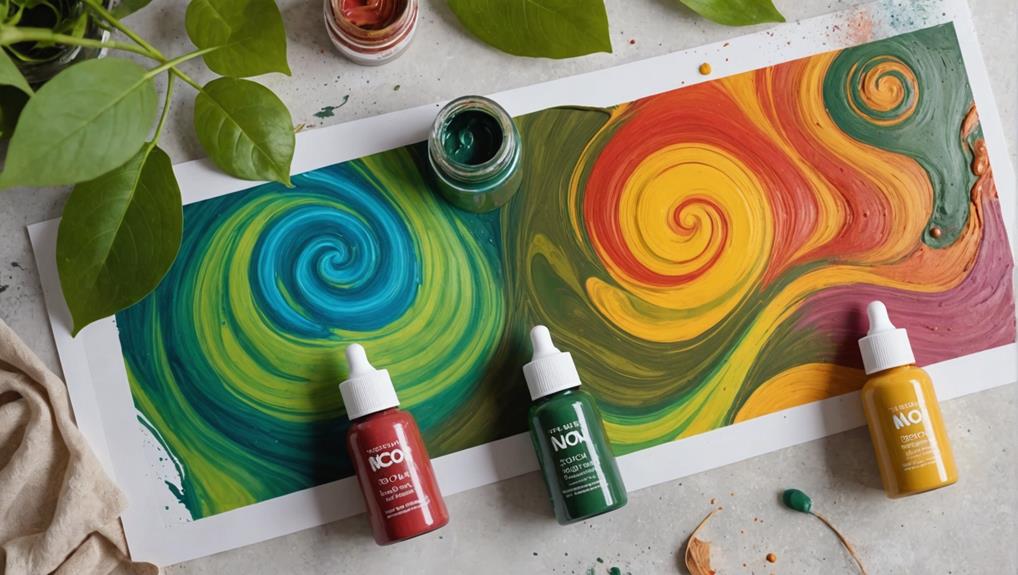
Exploring non-toxic paint varieties reveals numerous eco-friendly options that cater to the needs of fluid artists while ensuring minimal environmental impact.
Water-based paints, such as acrylic and gouache, are popular non-toxic choices, minimizing harmful chemical exposure and offering vibrant colors for creative fluid art techniques. These paints provide a safer alternative, ensuring artists can work without compromising their health or the environment.
Milk paints are another excellent option, made from natural ingredients and biodegradable, making them a sustainable choice for fluid art. These paints, derived from natural dye techniques, offer a rich palette while upholding eco-friendly principles.
Non-toxic watercolor paints also stand out, utilizing organic binders like gum arabic. They are safe for all ages, easy to clean up with water, and perfect for fluid art applications.
Further enhancing the range of non-toxic options, earth pigments derived from sustainable color sourcing provide archival-quality colors that enhance the vibrancy and durability of fluid art creations.
Additionally, low-VOC and zero-VOC paints are available in various hues, ensuring a safer indoor environment while allowing for creative expression.
Embracing these non-toxic paint varieties enables fluid artists to create stunning works of art responsibly.
Eco-Friendly Painting Techniques
How can fluid artists adopt eco-friendly painting techniques to guarantee their art is both stunning and sustainable?
One effective way is by embracing eco-friendly materials and sustainable techniques that don't compromise on quality or beauty. For instance, water-based paints are a fantastic alternative to traditional oil-based options. They contain fewer volatile organic compounds (VOCs), which means better indoor air quality during and after painting.
Another great method is to use natural and biodegradable mediums like plant-based gels and walnut oil. These can replace harmful solvents and thinners, making the working environment safer for everyone.
Homemade paints with earth pigments not only eliminate toxins but also provide vibrant colors and excellent durability, perfect for fluid art. Additionally, incorporating natural binders such as gum arabic or casein can enhance the effectiveness of your artwork while keeping it non-toxic.
Finally, using recycled or eco-friendly canvases like hemp or organic cotton supports sustainable practices and reduces the environmental impact of your projects.
- Water-based paints: Lower VOCs, better air quality.
- Natural mediums: Plant-based gels, walnut oil.
- Homemade paints: Earth pigments, vibrant colors.
Environmental Impact
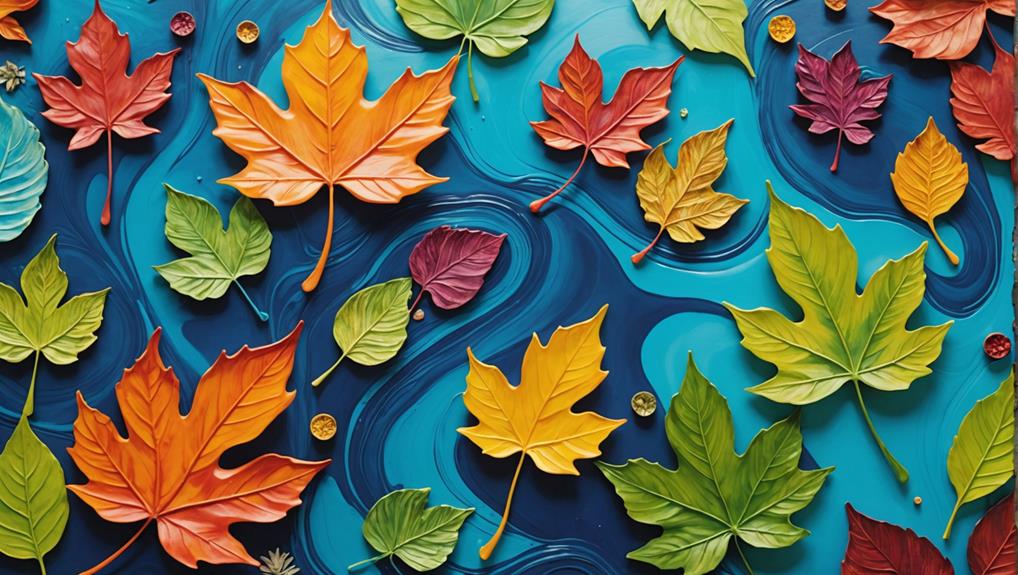
Adopting eco-friendly painting techniques not only enhances the safety and sustainability of fluid art but also markedly mitigates its environmental impact. Traditional art supplies often contain volatile organic compounds (VOCs) that contribute to indoor air pollution and respiratory issues. By switching to eco-friendly initiatives, artists can considerably reduce these emissions, creating healthier environments.
Additionally, non-toxic and biodegradable materials minimize the risk of harmful chemicals seeping into soil and water systems. Eco-friendly paints, often sourced from plant-based ingredients, support sustainable sourcing and reduce toxic exposure during application. This shift is not just about safety; it's about a broader commitment to the planet.
The growing market demand for non-toxic paints reflects a societal push towards sustainability. Brands are responding by expanding their eco-conscious product lines, catering to environmentally aware consumers. Moreover, the use of recycled materials in art supplies helps decrease waste and carbon footprints.
Here's a quick comparison of traditional versus eco-friendly art supplies:
| Aspect | Traditional Supplies | Eco-Friendly Supplies |
|---|---|---|
| VOC Emissions | High | Low |
| Chemical Leaching | Potentially harmful | Minimal |
| Ingredient Source | Synthetic | Plant-based |
| Market Demand | Decreasing | Increasing |
| Waste Reduction | Limited | Considerable |
Engaging With Eco-Art Community
Connecting with fellow artists who share your passion for eco-friendly practices can be incredibly inspiring.
Online forums, social media groups, and local workshops are great places to exchange ideas and learn new techniques for sustainable art.
Connecting With Fellow Artists
Engaging with eco-friendly art communities can greatly enhance your practice by providing valuable resources, inspiration, and collaborative opportunities.
Imagine connecting with fellow artists who are just as passionate about sustainability as you are! By participating in these communities, you open doors to artistic collaboration and eco-friendly networking, fueling your creativity while helping the planet.
Joining online forums and social media groups dedicated to eco-friendly art is a fantastic way to share tips and discover new materials that others have tested. You can find recipes for homemade non-toxic paints and mediums specifically for fluid art, which is super exciting!
- Online forums and social media groups: Meet like-minded artists, exchange tips, and discover non-toxic materials.
- Local art workshops and events: Collaborate on eco-friendly projects and build a supportive network.
- Monthly newsletters from eco-conscious organizations: Stay updated on competitions, showcases, and new opportunities.
Participating in local workshops or eco-art fairs can be incredibly inspiring. You not only gain new ideas but also form lasting connections with artists who share your commitment to the environment.
It's amazing how supportive and resourceful these communities can be!
Sharing Sustainable Practices
How can artists effectively share sustainable practices within eco-art communities to promote environmental responsibility?
Engaging with these communities offers incredible opportunities to learn and share eco-friendly techniques. One way is by attending local workshops or joining online forums where artists can exchange ideas and DIY recipes for non-toxic paints. Imagine creating your own paint from natural ingredients like earth pigments and plant-based binders—how cool is that?
Another fantastic method is using recycled materials in your fluid art. Many eco-artists repurpose old canvases and containers, which not only reduces waste but also saves money. Sharing tips on sustainable sourcing, like finding eco-friendly materials and supporting brands that prioritize environmental responsibility, can make a big difference too.
Staying connected is essential, so subscribing to newsletters from eco-conscious art organizations is a great idea. These newsletters often feature competitions, the latest innovations in non-toxic materials, and other sustainable practices.
Resources for Non-Toxic Art
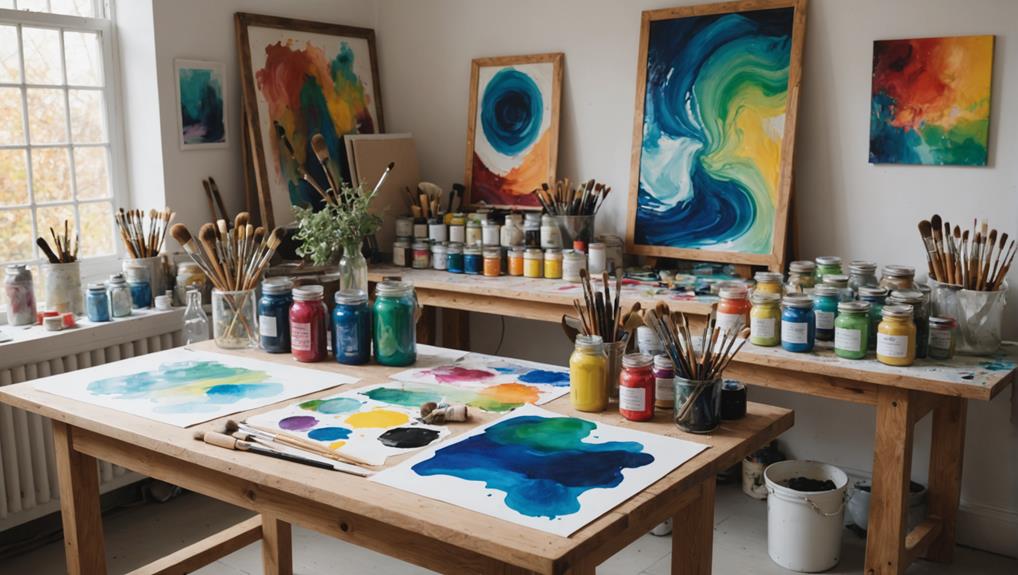
Artists seeking to minimize their environmental impact can turn to a variety of non-toxic art supplies that prioritize both safety and sustainability. Numerous products cater to eco-conscious creators, ensuring their materials do not harm the planet or personal health. Certifications like the U.S. ASTM D 4236 seal offer assurance that these art supplies meet stringent safety standards. Sustainable sourcing is also essential, ensuring that materials are responsibly harvested and processed with minimal environmental footprint.
By exploring these options, artists can embrace eco-friendly alternatives:
- Natural Earth Paint: This brand utilizes plant and mineral pigments, creating non-toxic options that are safe for all ages and environmentally sustainable.
- Watercolor Paints with Organic Binders: Made with non-toxic binders like gum arabic, these paints are easy to clean with water, ideal for fluid art techniques.
- Eco-Kids Art Supplies: Offering biodegradable and non-toxic materials, including plant-based finger paints and crayons made from food-safe ingredients, tailored for young artists.
Safe Painting Practices
Implementing safe painting practices is essential for protecting both personal health and the environment during the creation of fluid art. Choosing non-toxic paint options like water-based acrylics or natural earth pigments can greatly reduce exposure to harmful chemicals, allowing for creative expression without compromising well-being.
Proper ventilation is key. Even when using non-toxic materials, ensuring your workspace is well-aired helps minimize the inhalation of any fumes that might be released. This means you can enjoy artistic freedom without worrying about what you're breathing in.
Using natural or plant-based binders, such as gum arabic or methylcellulose, further supports a safe and eco-friendly painting environment. These alternatives are not just better for you but also for the planet.
Plus, cleaning your tools with natural soap and water instead of harsh solvents prevents the release of harmful VOCs, which contribute to indoor air pollution.
And let's not forget about disposal! Make sure to follow local hazardous waste guidelines when getting rid of leftover paint. This helps prevent environmental contamination and keeps our communities safe.
Frequently Asked Questions
What Is a Non-Toxic Alternative to Acrylic Paint?
A non-toxic alternative to acrylic paint is the use of plant-based pigments combined with natural binders, such as gum arabic or walnut oil. These materials provide vibrant, safe options for artists seeking environmentally friendly solutions.
What Is a Non-Toxic Substitute for Liquin?
A non-toxic substitute for Liquin includes natural mediums like M Graham Walnut Alkyd Medium or safe solvents such as Gamblin's solvent-free gel and liquid medium made from safflower oil, which provide safer options with less yellowing.
How Can Art Be More Environmentally Friendly?
Art can be more environmentally friendly by utilizing sustainable materials and adopting eco-conscious practices. This includes using biodegradable paints, natural pigments, non-toxic binders, and reusing or recycling art supplies to minimize waste and environmental impact.
What Is the Most Environmentally Friendly Artist Paint?
The most environmentally friendly artist paints are those incorporating natural pigments and plant-based paints. These options, such as milk paints and eco-friendly acrylics, minimize harmful chemicals and emissions, promoting sustainable and safe artistic practices.
Conclusion
In conclusion, adopting non-toxic and eco-friendly alternatives in fluid art fosters both artist health and environmental sustainability.
Utilizing eco-friendly solvents, water-mixable oil paints, and methylcellulose for gesso reduces harmful exposures.
Engaging with the eco-art community and adhering to safe painting practices further promote a healthier creative process.
The change to these alternatives is essential for minimizing the environmental impact of art-making while maintaining artistic expression.
Resources abound to support artists in this important shift.


Leave a Reply